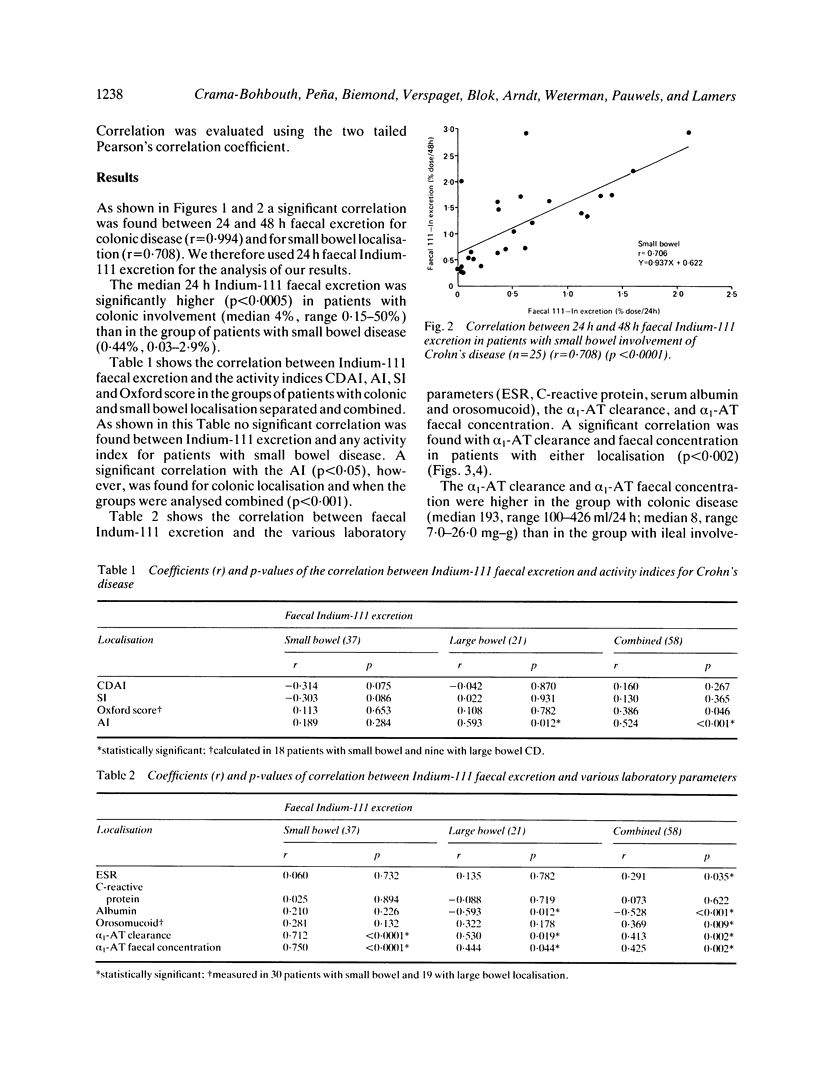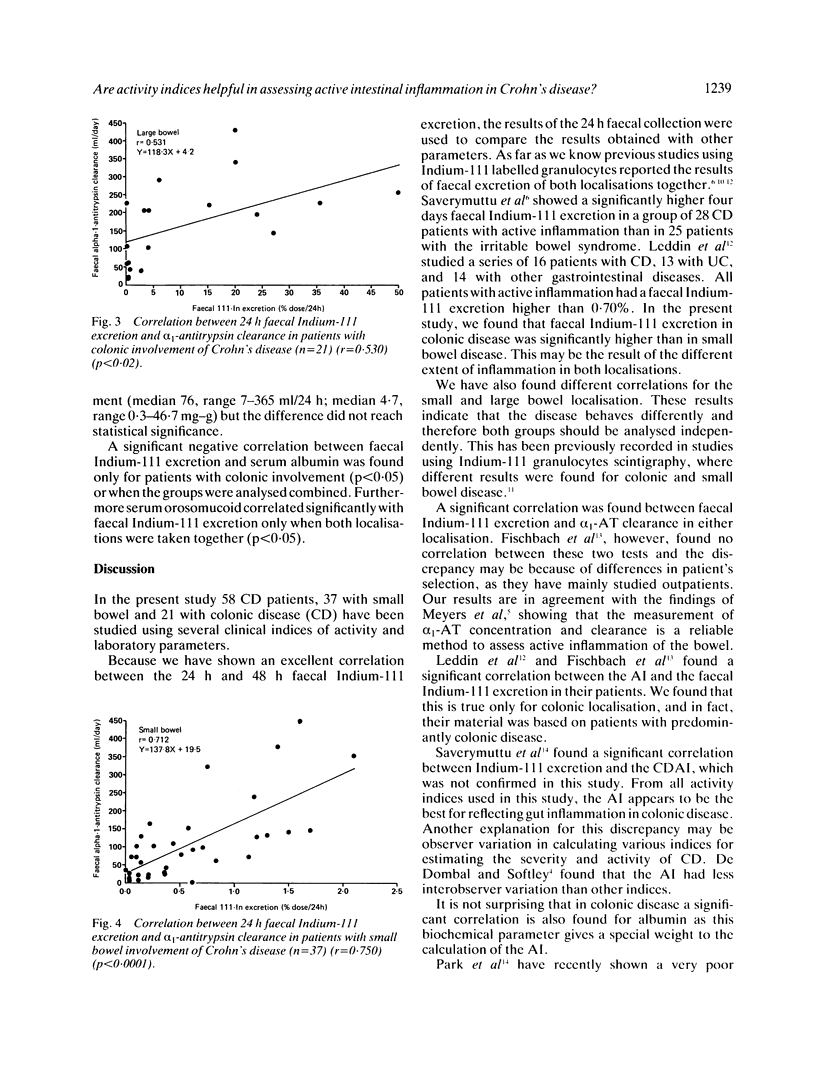Abstract
We have investigated the correlation of 24 h and 48 h faecal Indium-111 excretion with each other and with several clinical activity indices for Crohn's disease (CD): Crohn's disease activity index (CDAI), activity index (AI), simple index (SI), Oxford score, and laboratory parameters, such as ESR, serum albumin, orosomucoid, C-reactive protein, alpha-l-antitrypsin (alpha 1-AT) faecal concentration, and alpha 1-AT clearance in 58 CD patients (37 with small bowel and 21 with colonic disease). A significant correlation was found between 24 and 48 h faecal Indium-111 excretion for small bowel (r = 0.708, p less than 0.0001) and colonic disease (r = 0.994, p less than 0.0001). The median faecal Indium-111 excretion for colonic involvement (4%; 0.15-50% median and range) was significantly (p less than 0.005) higher than that for small bowel disease (0.45%; 0.03-2.9%). No significant correlation was found between faecal Indium-111 excretion and any activity index in the patients with small bowel disease, while in the group of patients with colonic localisation only the AI showed a significant correlation (r = 0.593, p less than 0.02). Faecal Indium-111 excretion was significantly correlated with alpha 1-AT clearance (r = 0.712, p less than 0.0001) and faecal alpha 1-AT concentration (r = 0.750, p less than 0.0001) in small bowel and in colonic localisation (r = 0.530, p less than 0.02 and r = 0.444, p less than 0.05). Serum albumin was significantly correlated only in the group of patients with colonic disease (r = -0.593, p less than 0.05). The present study shows poor agreement between activity indices, serum parameters of activity and faecal Indium-111 excretion. As a good correlation was found with the alpha1-clearance, which reflects losses into the gut, these results may suggest that faecal Indium excretion does not only reflect activity of inflammation, but my relate to the extent of intestinal ulceration.
Full text
PDF




Selected References
These references are in PubMed. This may not be the complete list of references from this article.
- Best W. R., Becktel J. M., Singleton J. W. Rederived values of the eight coefficients of the Crohn's Disease Activity Index (CDAI). Gastroenterology. 1979 Oct;77(4 Pt 2):843–846. [PubMed] [Google Scholar]
- Crama-Bohbouth G. E., Arndt J. W., Peña A. S., Verspaget H. W., Tjon A Tham R. T., Weterman I. T., Pauwels E. K., Lamers C. B. Value of indium-111 granulocyte scintigraphy in the assessment of Crohn's disease of the small intestine: prospective investigation. Digestion. 1988;40(4):227–236. doi: 10.1159/000199659. [DOI] [PubMed] [Google Scholar]
- Fischbach W., Becker W., Mössner J., Koch W., Reiners C. Faecal alpha-1-antitrypsin and excretion of 111indium granulocytes in assessment of disease activity in chronic inflammatory bowel diseases. Gut. 1987 Apr;28(4):386–393. doi: 10.1136/gut.28.4.386. [DOI] [PMC free article] [PubMed] [Google Scholar]
- Harvey R. F., Bradshaw J. M. A simple index of Crohn's-disease activity. Lancet. 1980 Mar 8;1(8167):514–514. doi: 10.1016/s0140-6736(80)92767-1. [DOI] [PubMed] [Google Scholar]
- Keshavarzian A., Price Y. E., Peters A. M., Lavender J. P., Wright N. A., Hodgson H. J. Specificity of indium-111 granulocyte scanning and fecal excretion measurement in inflammatory bowel disease--an autoradiographic study. Dig Dis Sci. 1985 Dec;30(12):1156–1160. doi: 10.1007/BF01314050. [DOI] [PubMed] [Google Scholar]
- Saverymuttu S. H., Camilleri M., Rees H., Lavender J. P., Hodgson H. J., Chadwick V. S. Indium 111-granulocyte scanning in the assessment of disease extent and disease activity in inflammatory bowel disease. A comparison with colonoscopy, histology, and fecal indium 111-granulocyte excretion. Gastroenterology. 1986 May;90(5 Pt 1):1121–1128. doi: 10.1016/0016-5085(86)90376-8. [DOI] [PubMed] [Google Scholar]
- Saverymuttu S. H., Peters A. M., Lavender J. P., Pepys M. B., Hodgson H. J., Chadwick V. S. Quantitative fecal indium 111-labeled leukocyte excretion in the assessment of disease in Crohn's disease. Gastroenterology. 1983 Dec;85(6):1333–1339. [PubMed] [Google Scholar]
- Segal A. W., Ensell J., Munro J. M., Sarner M. Indium-111 tagged leucocytes in the diagnosis of inflammatory bowel disease. Lancet. 1981 Aug 1;2(8240):230–232. doi: 10.1016/s0140-6736(81)90477-3. [DOI] [PubMed] [Google Scholar]
- de Dombal F. T., Softley A. IOIBD report no 1: Observer variation in calculating indices of severity and activity in Crohn's disease. International Organisation for the Study of Inflammatory Bowel Disease. Gut. 1987 Apr;28(4):474–481. doi: 10.1136/gut.28.4.474. [DOI] [PMC free article] [PubMed] [Google Scholar]


